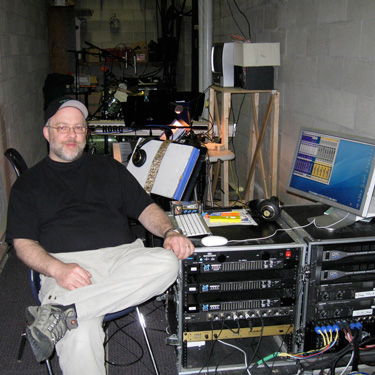|
 Steve Devino seated in front of the three Metric Halo 2882s in the orchestra pit for “Little Shop of Horrors.” Steve Devino seated in front of the three Metric Halo 2882s in the orchestra pit for “Little Shop of Horrors.”
BOSTON, MASSACHUSETTS: Steve Devino, owner of sound production company Granite Rocks Live, relies on three Metric Halo Mobile I/O 2882 units to meet the often-complex demands of theatricals, concerts, and special events. Although he typically pairs them with an analog console to provide outboard processing or with a digital mixer to add routing and submixing capabilities, the flexibility and reliability of Metric Halo’s 2d and v5 upgrades have begun to change that protocol. More and more, Devino finds himself deploying the Mobile I/O 2882s as standalone, computer-operated mixing systems.
“In a situation that calls for my 48-channel APB Dynasonics analog board, I’ll generally use Mobile I/O 2882s to do all the outboard processing in place of external compressors and EQs,” explained Devino, who is based in the greater Boston area. The 2d plug-ins offer easy routing to and from console inserts with DSP functions such as gating, dynamics, reverb, and EQ. Plus, he noted, “The ability to store the DSP, routing, and preamp settings as a saved boot state allow me to ‘set and forget’ the system. There’s no further need to access the computer unless changes are needed. I’ll also typically use one Mobile I/O 2882 as a FOH processor or matrix.”
In theatrical productions, large FOH rigs eat up revenue-generating seats. “When I need a small footprint but still need the Yamaha DM1000 digital mixer, I treat the Mobile I/O 2882s like a remote digital console,” Devino shared. “I keep the computer at FOH but tuck the Mobile I/O 2882s in the orchestra pit or backstage and then operate them remotely over Cat 6. I use two of the Mobile I/O 2882s, one for the orchestra mixer and another on a separate computer as an in-ear monitor mixer. The v5 software has proven flexible enough to facilitate a simple mixer that the band members can operate by themselves with only a five-minute training session.”
He added, “By keeping the Mobile I/O 2882s remote, signals feed into the converters right where the musicians are. That minimizes cable runs and improves overall quality. And because I can connect one unit to another in the digital domain, I don’t need to do multiple A-to-D and D-to-A conversions. That also improves overall quality.”
For a typical theatrical production, Devino will often use a third Mobile I/O 2882 interfaced with industry-standard QLab sound effects system software. “The Mobile I/O 2882 is really great for theater because you have eighteen outputs and eighteen inputs, and anything can be connected to anything. I have an orchestra PA, a vocal PA, and additional sound effects speakers. Although I keep the orchestra and vocals completely separate in the Mobile I/O 2882, their matrix capabilities allow me to route anything from QLab (which supports sixteen outputs) to any speaker without resorting to crazy interconnects.”
Metric Halo’s SpectraFoo software analysis tool also proves valuable in multi-speaker theatrical setups. Devino noted, “It’s great, especially when I’m hanging a lot of speakers. I use SpectraFoo to figure out the delays. There’s nothing simpler, faster, or more accurate than SpectraFoo.”
For a recent production of “The Laramie Project” by The Peacock Players in New Hampshire, Devino ran the show without an audio console, relying entirely on his Metric Halo Mobile I/O 2882s. “The Mobile I/O 2882s were in a rack in the pit,” he explained. “We just put a Mac Mini with a monitor at the stage manager’s desk and that was it.”
Devino used a similar configuration for Boston Medical Center’s “Halloween Town” at the Seaport World Trade Center. On one stage, he used the APB console with a Mobile I/O 2882 providing outboard DSP to mix former Del Fuego and Funhouse Disney favorite, Dan Zanes. “At each of two smaller stages, which featured solo performers, I set up a computer with a Mobile I/O 2882 and a patching point,” he said. “Each computer had channels for a wireless mic, a piano or a guitar. Without any audio professionals on site, performers simply plugged in and turned on the appropriate channels. Because I had the boot state stored, if somebody got completely tied up in knots, I could easily go back to a pre-established, fully-functional state.”
Devino noted that even though it is considerably less expensive, the audio quality of his Metric Halo-based system is equal to or better than a comparable digital mixer. Further, the operational capabilities of the Mobile I/O 2882 offer additional improvements to typical signal flow in a theatrical production. “I don’t need to have a mic splitter,” he said, “because I can simply take the digital output from one Mobile I/O 2882 and go digitally into another Mobile I/O 2882 – and that’s the split! It saves a lot of copper and patching.”
“The 2d/v5 upgrades to my Metric Halo-based system have brought many compliments on the sound quality of my productions from audience members, musicians and other technical staff. As someone who really enjoys working with high-quality audio, I love having the routing flexibility and satisfying fidelity of this system at my disposal. It has completely changed my approach to live sound,” Devino concluded. |